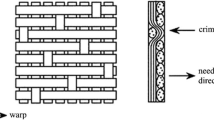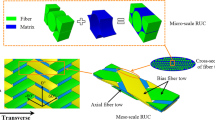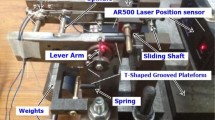Abstract
In-plane compression experiments are performed on 3D fine weave pierced C/C composite at a wide strain rate range of 0.0001/s–1000/s. The in-plane compressive failure mechanism of the composite at quasi-static and high strain rates is analyzed by a scanning electron microscope. The results show that the in-plane compressive modulus, maximum stress and the corresponding strain increase with increasing strain rate. The quasi-static in-plane compressive failure mode of the 3D fine weave pierced C/C composite is characterized by the shear failure at the angle of \(45^{\circ }\) and the local buckling of the x-direction fiber bundles. In comparison, the high strain rate in-plane compression failure mode of the composite is characterized by the compressive fracture of the interlaminar matrix and the progressive compression failure of the x-direction fiber bundles. A strain-rate-dependent in-plane compressive constitutive model is proposed to predict the dynamic in-plane compressive response of the composite. The proposed constitutive model is verified by experimental data.











Similar content being viewed by others
References
Corral EL, Loehman RE. Ultra-high-temperature ceramic coatings for oxidation protection of carbon–carbon composites. J Am Ceram Soc. 2008;91(5):1495–502.
Guo F, Fei QG, Li YB, Zhang PW, Wang M, Yu JW. Novel statistical analysis method for determining shear strength of C/C composite pin. Ceram Int. 2020;46(4):5262–70.
Guo F, Fei QG, Li YB, Zhang PW, Yu JW. Shear strength distribution and constitutive model of C/C composite pins based on Weibull model. Acta Mater Compos Sin. 2019;36(2):461–8.
**e WH, Yang F, Meng SH, Scarpa F, Wang LB. Perforation of needle-punched carbon–carbon composites during high-temperature and high-velocity ballistic impacts. Compos Struct. 2020;245:112224.
Rana S, Fangueiro R. Advanced composites in aerospace engineering. In: Rana S, Fangueiro R, editors. Advanced composite materials for aerospace engineering. Cambridge: Woodhead Publishing; 2016. p. 1–15.
Guo F, Zhang PW, Zhang DH, Han XL, Fei QG. Localization of low-velocity impact by using fiber Bragg grating sensors based on wavelet packet energy eigenvector. J Vib Shock. 2017;36(08):184–9.
Ghannadpour SAM, Mehrparvar M. Energy effect removal technique to model circular/elliptical holes in relatively thick composite plates under in-plane compressive load. Compos Struct. 2018;202:1032–41.
Choi IH. Low-velocity impact analysis of composite laminates under initial in-plane load. Compos Struct. 2008;86(1–3):251–7.
Kyriakides S, Arseculeratne R, Perry EJ, Liechti KM. On the compressive failure of fiber reinforced composites. Int J Solids Struct. 1995;32(6–7):689–738.
Zhou G, Rivera LA. Investigation for the reduction of in-plane compressive strength in preconditioned thin composite panels. J Compos Mater. 2005;39(5):391–422.
Chen J, An QL, Chen M. Transformation of fracture mechanism and damage behavior of ceramic-matrix composites during nano-scratching. Compos A Appl S. 2020;130:105756.
Li DS, Duan HW, Wang W, Ge DY, Jiang L, Yao QQ. Strain rate and temperature effect on mechanical properties and failure of 3D needle-punched carbon/carbon composites under dynamic loading. Compos Struct. 2017;172:229–41.
Guo F, Fei QG, Zhang PW, Li YB, Wang M, Gupta N. Dynamic shear fracture behaviors and “pseudo-plastic” constitutive model of carbon/carbon composite pins. Int J Mech Sci. 2020;187:105903.
Davies IJ, Rawlings RD. Mechanical properties in compression of low density carbon/carbon composites. Composites. 1994;25(3):229–36.
Yuan QL, Li YL, Li HJ, Li SP, Guo LJ. Quasi-static and dynamic compressive fracture behavior of carbon/carbon composites. Carbon. 2008;46(4):699–703.
Yang BJ, Kim BR, Lee HK. Predictions of viscoelastic strain rate dependent behavior of fiber-reinforced polymeric composites. Compos Struct. 2012;94(4):1420–9.
Daniel IM, Cho JM, Werner BT, Fenner JS. Characterization and constitutive modeling of composite materials under static and dynamic loading. AIAA J. 2011;49(8):1658–64.
Sun L, Wang C, Li XF, Li H, Ye MY, An C. Research progress on preforms of C/C composites. J Aeronaut Mater. 2018;38(2):86–95.
Breumier S, Sao-Joao S, Villani A, Levesque M, Kermouche G. High strain rate micro-compression for crystal plasticity constitutive law parameters identification. Mater Design. 2020;193:108789.
Zhang M, Wu HJ, Li QM, Huang FL. Further investigation on the dynamic compressive strength enhancement of concrete-like materials based on split Hopkinson pressure bar tests. Part I: experiments. Int J Impact Eng. 2009;36(12):1327–34.
Lai YM, Li SY, Qi JL, Gao ZH, Chang XX. Strength distributions of warm frozen clay and its stochastic damage constitutive model. Cold Reg Sci Technol. 2008;53(2):200–15.
Li YL, Suo T, Liu MS. Influence of the strain rate on the mechanical behavior of the 3D needle-punched C/SiC composite. Mater Sci Eng A Struct. 2009;507(1–2):6–12.
Ypma TJ. Historical development of the Newton–Raphson method. SIAM Rev. 1995;37(4):531–51.
Acknowledgements
This paper is supported by the National Natural Science Foundation of China (11802059, 11572086), the Jiangsu Natural Science Foundation (BK20170656, BK20170022) and the Zhishan Youth Scholar Program of Southeast University. Author NG thanks the Mechanical and Aerospace Engineering Department at NYU for providing facilities and support.
Author information
Authors and Affiliations
Corresponding author
Rights and permissions
About this article
Cite this article
Guo, F., Fei, Q., Li, Y. et al. Strain-Rate-Dependent In-Plane Compressive Properties of 3D Fine Weave Pierced C/C Composite: Failure Mechanism and Constitutive Model. Acta Mech. Solida Sin. 35, 63–78 (2022). https://doi.org/10.1007/s10338-021-00243-x
Received:
Revised:
Accepted:
Published:
Issue Date:
DOI: https://doi.org/10.1007/s10338-021-00243-x




